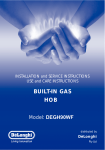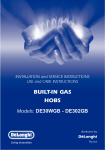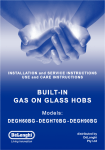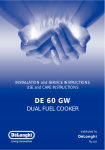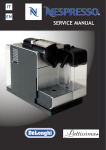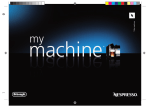Download DeLonghi WIR2 NAT GAS Specifications
Transcript
LGHS 90II DGHS 90II COOKTOPS INSTALLATION and SERVICE INSTRUCTIONS USE and CARE INSTRUCTIONS distributed by DèLonghi Pty Ltd Use and Care INSTALLATION CAUTION: < This appliance must be installed in accordance with these installation instructions, local gas fitting regulations, municipal building codes, water supply regulations, electrical wiring regulations, AS5601 / AG 601 - Gas Installations and ony other relevant statutory regulations. < This appliance shall only be serviced by authorized personnel. WARNING: < This appliance is to be installed only by an authorised person. < This appliance must be used only for the task it has explicity been designed for, that is for cooking foodstuffs. Any other form of usage is to be considered as inappropriate and therefore dangerous. < Do NOT place combustible materials or products on this appliance at any time. < Do NOT spray aerosols in the vicinity of this appliance while it is in use. This hob has been designed and constructed in accordance with the following codes and specifications: AGA101 AS/NZS 3350-1 AS/NZS 3350-2-6 AS/NZS 1044 Approval requirements for Domestic Gas cooking appliances General requirements for Domestic electrical appliances Particular requirements for Domestic electrical cooking appliances Electromagnetic Compatibility requirements IMPORTANT NOTE: THIS APPLIANCE SHALL NOT BE USED AS A SPACE HEATER, ESPECIALLY IF INSTALLED IN MARINE CRAFT OR CARAVANS. NOMINAL GAS CONSUMPTION AND INJECTOR SIZES (Table 1): Natural Gas LPG 1.0 2.75 Test Point Pressure (kPa) Injector Orifice [mm] Gas Consumption [MJ/h] Injector Orifice [mm] Gas Consumption [MJ/h] Simmer 0.70 2.4 0.47 2.9 Semi-rapid no.1 0.90 4.0 0.60 4.7 Semi-rapid no.2 1.15 6.5 0.76 7.5 Wok burner 1.45 11.0 0.90 10.4 Fish burner 1.45 11.0 0.90 10.4 Burner (Note: Gas type sticker and data are attached to the underside of the base of the appliance.) 2 Figure 1 DIMENSIONS (Table 2): (Note: Also refer to Figure 1) General Dimensions Width 860 mm Depth 500 mm Depth Below Mounting Surface 30 mm Cut-out Dimensions Width 840 mm Depth 480 mm 3 Use and Care INSTALLATION Installation clearances and protection of combustible surfaces shall comply with CLEARANCES: the requirements of AS5601 / AG 601 - Gas Installations. 4 750 mm 450 mm Figure 2 The installation shall comply with the dimensions in Figures 1 and 2 bearing in mind that: < < < < A minimum distance of 20 mm has to be kept between the bottom of the cooking hob and the top of an appliance or a shelf. To ensure this clearance, mount the spacers, supplied with the appliance as shown in the figure below. A partition between the base of the hob and the cupboard below should be fitted 100 mm below the workbench surface if the cupboard is to be used for storage. Overhead clearances - In no case shall the clearances between the highest part of the hob and a range hood be less than 600 mm, or for an overhead exhaust fan, 750 mm. Any other downward facing combustible surface less than 600 mm above the highest part of the hob shall be protected for the full width and depth of the cooking surface area in accordance with local regulations in force. However, in no case shall this clearances to any surface be less than 450 mm. Side clearances - Where the dimension from the periphery of the nearest burner to any vertical combustible surface is less than 200 mm, the surface shall be protected in accordance with local regulations in force to a height of not less than 150 mm above the hob for the full dimension (width or depth) of the cooking surface area. Protection of combustible surfaces - Local regulations in force specify that where required, protection shall ensure that the surface temperature of the combustible surface does not exceed 50°C above ambient. The fixing of 5 mm thick ceramic tiles to the surface or attaching fire resistant material to the surface and covering with sheet metal with minimum thickness of 0.4 mm would satisfy this requirement. 20 mm < Spacer Double sided adhesive tape Figure 3 5 INSTALLATION (Refer to Figures 4a and 4b): < Spread out the gasket “C” over the workbench of the edge of the cut out taking care to overlap the gasket of the corners. < Slot in the cooking hob into the cut out of the workbench and locate it correctly. < Adjust the clamps “A” and tighten the screws “B” until the hob is firmly secured. < Using a sharp tool, trim any excess gasket which protrudes from the edge of the hob. < Assemble the three piece burners. Take care to properly locate the assembled burner on the burner base. Figure 4a B A Figure 4b 6 40 mm max. 40 mm max. A 20 mm min. B 20 mm min. C C GAS SUPPLY: < This appliance is suitable for use with Natural Gas or LPG. (Check the “gas type” sticker attached to the appliance). < For Natural Gas the gas supply must be regulated to obtain a pressure of 1 kPa with the two semi-rapid burners operating at maximum. < For LPG models connect the gas supply directly to the appliance test point adaptor (supplied with the conversion kit) and ensure that the supply pressure is regulated to 2.75 kPa. < Do NOT force the “elbow” rotation prior to loosening the nut. < Do NOT over tighten the nut at the “elbow”. 1. After connecting the gas supply, check the piping and connections for leaks using a soap and water solution. The presence of bubbles indicates a leak, tighten or replace connections as appropriate. 2. Adjust the test point pressure or supply pressure to the value which is appropriate for the gas type. 3. Turn on the appliance gas controls and light each burner. Check for a well defined blue flame without any yellow tipping. If any abnormality is evident then check that the burner cap is located properly and the injector nipple is aligned correctly. 4. Check the minimum burner setting by quickly rotating the gas control knob from the maximum to the minimum position, the flame must not go out. If adjustment is required, carry out the “minimum burner setting adjustment” procedure described below. 5. If satisfactory performance cannot be obtained, the installer shall check the installation and notify the local gas supply authority for a gas supply problem, or if it is an appliance problem, our Customer Service Centre should be called to obtain the nearest authorised Service Agent. 6. Where the appliance data plate cannot be easily read with the appliance in the installed position the duplicate data plate must be attached to adjacent surfaces and the duplicate ULPG conversion label should also be included where a ULPG conversion has been completed. Gas connection for Natural Gas Gas inlet pipe Figure 5 Gas connection for LPG Gas inlet pipe Gasket Gasket Brass conical adaptor (Thread tight: use suitable seal) Brass conical adaptor (Thread tight: use suitable seal) Gas regulator Test point adaptor 7 CONVERSION PROCEDURE INJECTOR REPLACEMENT: This appliance is suitable for use with Natural Gas or LPG. (Check the gas type” sticker attached to the appliance.) The nominal gas consumption and injector size details are provided in Table 1. The conversione procedure must be carried out only by an authorised person. To replace injectors: 1. Remove the knobs and ignition push button. 2. Unscrew the “A” screw in Figure 6a. 3. Remove the control panel “B” in Figure 6a. 4. With a wrench “C” replace the injectors “J” with those suitable for the gas to be used (Figure 7a). 5. Affix to the appliance the warning label stating that the cooktop has been converted for use with ULPG (supplied with the ULPG conversion kit).A second ULPG conversion label should also be affixed to an adjacent surface along with the duplicate data plate. OR 1. Remove the pan-supports, the burners and the knobs. 2. Unscrew the 8 side screws “C” indicated in figure 6b, and the top screws “D”. 3. Remove the 4 rear plugs “T”. 4. With a wrench “C” replace the injectors “J” with those suitable for the gas to be used (Figure 7b). 5. Affix to the appliance the warning label stating that the cooktop has been converted for use with ULPG (supplied with the ULPG conversion kit).A second ULPG conversion label should also be affixed to an adjacent surface along with the duplicate data plate. Figure 6a Figure 6b D T T C 8 Figure 7a Figure 7b C C J J J J MINIMUM BURNER ADJUSTMENT: The minimum burner setting is adjusted as follows: 1. Turn on the burner. 2. Set the gas control to the minimum position. 3. Adjust the screw inside the gas cock shaft (see Figure 8a) to obtain a flame length of approximately 4 mm. OR Adjust the screw “A”on the side of the gas cock body (see Figure 8b) to obtain a flame length of approximately 4 mm. 4. Check that the burner remains alight when the control is turned quickly from maximum to minimum setting. Readjust the minimum setting if necessary. Figure 8a Figure 8b A 9 ELECTRICAL REQUIREMENTS: WARNING: 4 THIS APPLIANCE MUST BE EARTHED. CAUTION: 4 Ensure that the power outlet is properly earthed before connecting the appliance. 4 Disconnect power before servicing the appliance The appliance is provided with a standard 240VAC three pin plug and power cable (3x0.75 mm2). The wires in the power cable are coloured in accordance with the following code: Green/Yellow = Earth, Blue = Neutral, Brown =Active If the colours of the wires in the power cable to the appliance do not correspond with the coloured markings identifying the terminals in the junction terminal, proceed as follows: 1. The wire which is coloured green and yellow must be connected to the terminal marked E (Earth) or coloured green. 2. The wire which is coloured blue must be connected to the terminal marked N (Neutral) or coloured black. 3. The wire which is coloured brown must be connected to the terminal marked L (Live) or A (Active) or coloured red. Figure 9 A ELECTRIC DIAGRAM KEY A IGNITION COIL PA IGNITION SWITCH M TERMINAL BLOCK T EARTH CONNECTION PA T M 113930 10 Note: Servicing of this appliance is only to be carried out by Authorised Persons. REPLACEMENT OF IGNITION MODULE/ELECTRODES/GAS COCKS: 1. Turn off and disconnect gas supply and electricity. 2. Lift off trivets and burner heads, and pull off ignition push button and control knobs. 3. Undo the screws “B” and remove the clamps “A” shown in Figures 4a/4b and remove the hob. 4. Remove screws securing the top of the hob to the base pan and lift it off. 5. To replace the electrode, unhook the locking spring and remove the electrode and cable. 6. To remove the igniter module, disconnect the electrodes, power and igniter switch wires, undo the two retaining screws and remove the module. 7. To remove the gas cock undo the two screws which secure it to the gas manifold. On re-assembly ensure that the injectors are aligned with the burner venturi. 8. Reassemble in reverse order. 9. Check all connections for gas leaks with soapy water (including gas cocks if they have been removed). GAS COCK LUBRICATION: 1. Turn off the gas supply and disconnect electricity. 2. Remove the knobs and ignition push button. 3. Unscrew the “A” screw and remove the control panel “B” (Figure 6a). OR Remove the hob top by following points 1-3 in REPLACEMENT OF IGNITION MODULE/ELECTRODE/GAS COCKS section above. 4. Unscrew the two screws on top of the gas cock. 5. Lift out the valve cone, clean it with solvent and re-grease it with high temperature grease. 6. Replace the valve cone, move it around and remove excess grease. Remove it once again and check that internal holes or galleries are not blocked. 7. Replace and reassemble in reverse order. 8. Check for gas leaks with soapy water. 11 Use and Care USE and CARE CAUTION: 4 This appliance must be used only for the task it has explicitly been 4 4 4 4 12 designed for, that is for cooking foodstuffs. Any other form of usage is to be considered as inappropriate and therefore dangerous. Do not use this appliance as a space heater. Do NOT place combustible materials or products on this appliance at any time. Do NOT spray aerosols in the vicinity of this appliance while it is in use. Before using for the first time, clean the cooktop with warm soapy water. Use the coffee pot support to ensure that small cooking utensils are stable. Figure 10a Semi rapid burner no. 1 Semi rapid burner no. 2 mod. LGHS 90II Operates right rear burner Operates left rear burner Operates middle burner Operates left front burner Operates right front burner Ignition Wok burner Fish burner Simmer burner Figure 10b Semi rapid burner no. 1 Semi rapid burner no. 2 mod. DGHS 90II The hob is fitted with a safety cut-off device Operates right rear burner Operates left rear burner Operates middle burner Operates left front burner Operates right front burner Ignition Wok burner Fish burner Simmer burner 13 LIGHTING GAS BURNERS 4 Check that the electricity is switched on to allow spark ignition. 4 Make sure that all controls are turned to zero. 4 Model LGHS 90II: the gas flow to the burner is controlled by the knobs on the safety taps. 4 Model DGHS 90II: the gas flow to the burner is controlled by the knobs on 4 the taps incorporating a safety cut-off device. If the burner flame should go out, the safety cutoff valve will automatically stop the gas flow. You control the flow by turning the knob indicator to line up with the following symbols: Symbol : Off Symbol : Full on (maximum) Symbol : Minimum rate 4 Model LGHS 90 II: to ignite automatically, push the required knob down 4 4 4 4 14 and turn it to maximum then press the ignition button continuously until the burner lights. When the flame is lit, you can control the temperature by the knob. Model DGHS 90 II: to ignite automatically, push the required knob down and turn it to maximum, keeping the knob down, press the ignition button continuously until the burner lights. When the flame is lit, wait for about ten second with the knob down (safety cutoff device delay). You can control the temperature by the knob to “maximum” from “minimum rate”. To switch off, turn the knob clockwise until you hear the safety click. Note that, if you are using a burner at the minimum setting, you turn the knob clockwise past the maximum setting before reaching the off position. COOKING HINTS FOR GAS HOBS 4 The burners are different sizes, and can be used in different ways. 4 The largest can be used for boiling, to seal meat or foods that are cooked quickly, and the smallest for stews and sauces. 4 Always ensure that you use the correct size of saucepan. 4 For fast boiling, make sure the flame just reaches the edge of the pan. 4 Flames going up the side of the pan means wasted heat and the contents of the pan will take longer to boil. For optimum efficiency use a wok or pan no smaller than 230mm diameter. Figure 11 CORRECT USE OF DOUBLE-RING BURNER 4 The flat-bottomed pans are to be placed directly onto the pan-support. 4 To use the WOK you need to place the proper stand in order to avoid any faulty operation of the wok burner. Figure 12 WRONG CORRECT 15 CLEANING AND MAINTENANCE GENERAL ADVICE 4 It is advisable to clean when the appliance is cold and especially when cleaning the enamelled parts. 4 Avoid leaving alkaline or acid substances (lemon juice, vinegar, etc.) on the surfaces. 4 Avoid using cleaning products with a chlorine or acid base. ENAMELLED PARTS 4 All of the enamelled parts must be washed only with a sponge and soapy water or with non-abrasive products. Dry, preferably, with deer skin. STAINLESS STEEL 4 Clean with a suitable product. Always dry fully with a soft cloth or chamois. BURNERS AND RACKS 4 These parts may be removed and washed with suitable products. 4 Black burners (”OXI-BLACK” coating): They can be removed and washed only with soapy water. Detergents can be used but must not be abrasive or corrosive. Do not use abrasive sponges or pads. Do not put in dishwasher. 4 The burners and their caps must be well dried after cleaning and put back perfectly into their slots. It is very important to make certain the positioning of the burner-caps because a misplacing in their slots can cause serious damage. 4 In the appliances with electrical ignition for the burners, verify that the electrode is always cleaned well to ensure a regular spark. SERVICE AND MAINTENANCE If the ignition spark fails to ignite or does not light the gas, check the following items before calling our Customer Service Centre to obtain the nearest Authorised Service Agent: 4 Burner is reassembled and located correctly. 4 Spark electrode and white ceramic are clean and dry. 4 240 VAC power supply is connected. Contact the local gas utility or our Customer Service Centre to obtain the nearest Authorized Service Agent. 4 You can smell gas when all burners are turned on. 4 The burners do not remain alight at the minimum marked setting. 4 The burner flame is yellow or emits an unusual odour. Note that a bi-annual inspection of the appliance by an authorized service agent or your locate gas utility will ensure many years of trouble free operation of your appliance. 16 17 18 19 Code 1101579 - Ed.4 - b6 Descriptions and illustrations in this booklet are given as simply indicative. The manufacturer reserves the right, considering the characteristics of the models described here, at any time and without notice, to make eventual necessary modifications for their construction or for commercial needs.























